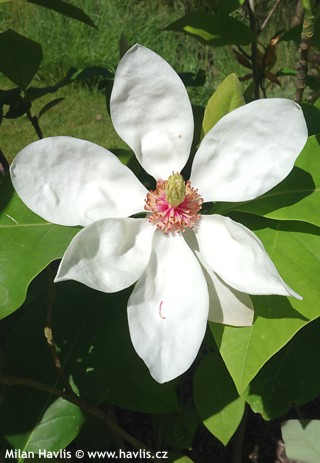Magnolia x wieseneri Watson's magnolia
Watson’s magnolia is a rare hybrid, first introduced to Europe at the World Exposition in Paris in 1889. It was brought from Japan and admired by a number of European botanists. Sir Joseph Dalton Hooker, director of the Royal Botanical Gardens at Kew near London was one of them and as it lacked a scientific name, in 1891 he decided to name it magnolia x watsonii (in honour of William Watson, former assistant curator at Kew). Probably due to the absence of information then (see how internet helps today?) he had no idea that the plant had already been given a name 6 months before – in 1890. It was named by another botanist Élie-Abel Carriére from France, after a man who purchased a specimen from the Japanese horticulturist at the exhibition – Mr.Wiesener – magnolia x wieseneri. Though this scientific name was given preference due to the time of origin, common name Watson’s magnolia is in general use until today.
Watson’s magnolia is a beautiful hybrid between Japanese bigleaf magnolia (m.obovata/m.hypoleuca) and Oyama magnolia (m.sieboldii). The result has the best of both the parents. Large, up to 20 cm long, fresh green, obovate leaves similar to those of the former one, and mid-sized, 12-15 cm across, creamy white, highly fragrant flowers with rich red anthers in the centre. They open later in the season, from late spring until early summer to midsummer, which is a feature common for the latter. Only exceptionally a couple of flowers may open up before the leaves unfold in May. Young plants develop a spreading, thinly branched structure, and thicken up with age when they become more rounded or oval in shape.
Magnolias are not supposed to be pruned. You can prune old shrubs if ill, or trim them to shape or to reduce size, or make an elementary cut to young plants of unsightly or unhealthy appearance. Do this as soon as possible after flowering to secure setting of flower buds for the following year. Be aware that each magnolia can respond differently to pruning.
Deciduous magnolias are quite easy plants. All they need is light, well-drained, acidic soil with equal moisture throughout the year. Once established they can do with occasional drought but will not look as nice as the ones with regular watering. Just pay attention to how to plant your magnolia. First, find it a spot where it will live forever and ever. It does not like transplanting. And as it makes shallow roots reaching well over its spread stay away from disturbing the roots by digging or messing about around it. Just cover the soil with bark mulch and do not plant anything else near it after say the second year after planting onwards. You could damage the very important top roots that absorb maximum moisture and nutrients from the soil. Also avoid planting magnolia too deep. It is hardy to about -27°or possibly even -29°C (USDA zone 5).
Last update 01-04-2013









































